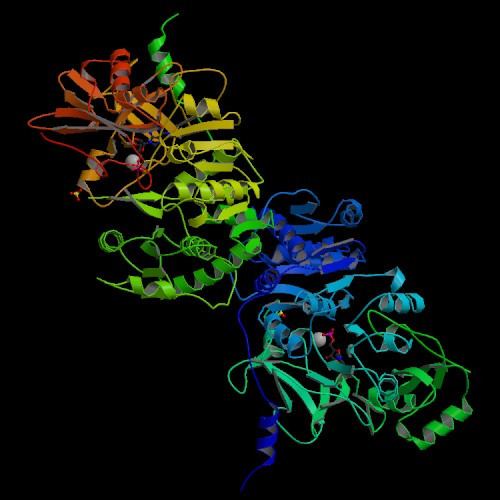EC number 5.1.1.11 ExPASy NiceZyme view | CAS number 37290-95-2 | |
 | ||
The enzyme phenylalanine racemase (EC 5.1.1.11, phenylalanine racemase, phenylalanine racemase (adenosine triphosphate-hydrolysing), gramicidin S synthetase I) is the enzyme that acts on amino acids and derivatives. It activates both the L & D stereo isomers of phenylalanine to form L-phenylalanyl adenylate and D-phenylalanyl adenylate, which are bound to the enzyme. These bound compounds are then transferred to the thiol group of the enzyme followed by conversion of its configuration, the D-isomer being the more favorable configuration of the two, with a 7 to 3 ratio between the two isomers. The racemisation reaction of phenylalanine is coupled with the highly favorable hydrolysis of adenosine triphosphate (ATP) to adenosine monophosphate (AMP) and pyrophosphate (PP), thermodynamically allowing it to proceed. This reaction is then drawn forward by further hydrolyzing PP to inorganic phosphate (Pi), via Le Chatelier's principle.
Contents
Other names
Pathway
Substrate
Product
Cofactor
Links to disease
Problems in the digestion of phenylalanine (phe) to tyrosine (tyr) lead to the buildup of both phe and phenylpyruvate, in a disease called Phenylketonuria (PKU). These two compounds build up in the blood stream and cerebral spinal fluid, which can lead to mental retardation if left untreated. Treatment consists of a restricted diet of foods that contain phe or compounds that can breakdown into phe. Children in the US are routinely tested for this at birth. For more information see the Phenylketonuria page or the link below.
Quick facts
L-Phe:D-Phe = 3:7
The reaction
Compound C00079 at KEGG Pathway Database. Compound C00002 at KEGG Pathway Database. Enzyme 5.1.1.11 at KEGG Pathway Database. Compound C00020 at KEGG Pathway Database. Compound C00013 at KEGG Pathway Database. Compound C00001 at KEGG Pathway Database. Reaction R00686 at KEGG Pathway Database. Pathway MAP00360 at KEGG Pathway Database. Compound C00018 at KEGG Pathway Database. |}
